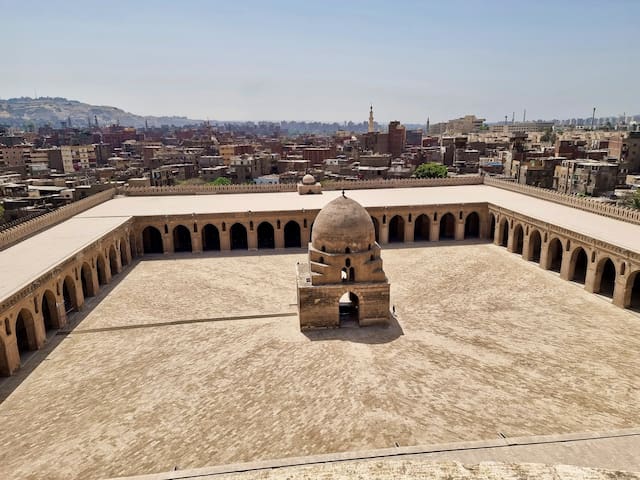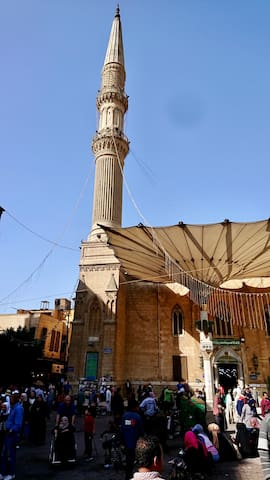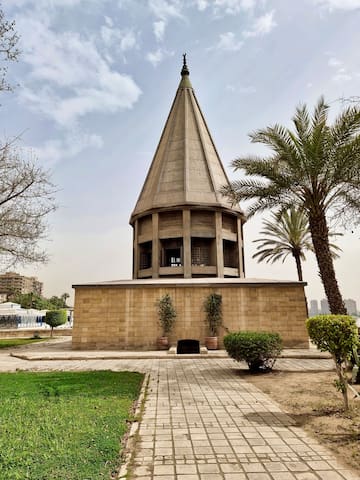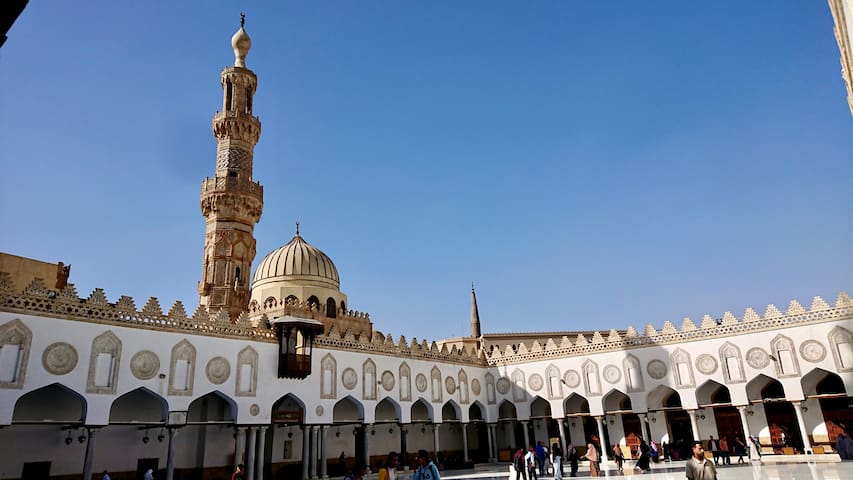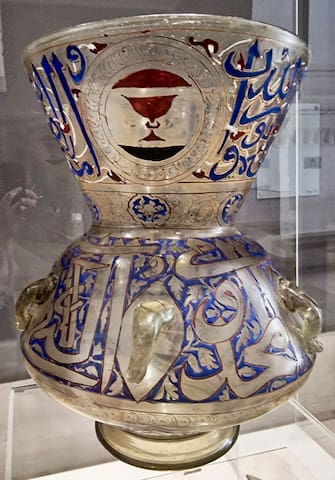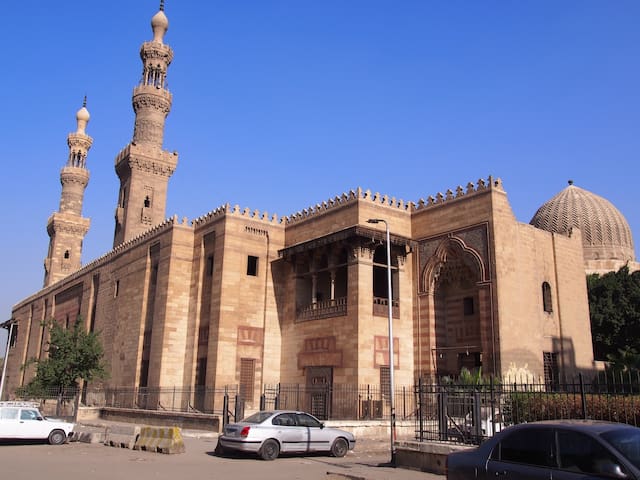Islamik Cairo
The Mosque of Ibn Tulun is one of the oldest mosques in Egypt and is considered to be one of the largest mosques in the world in terms of land area. It covers approximately 26,318 square meters and its construction is considered to be a masterpiece of Islamic architecture.
The mosque has been renovated and restored numerous times over the centuries, with the most recent restoration taking place in the early 2000s. The mosque has also been designated as a UNESCO World Heritage site.
In addition to its architectural significance, the Mosque of Ibn Tulun is also significant for its historical and cultural value. It is a popular destination for tourists and visitors to Cairo who are interested in Islamic history and architecture.
12 paikallista suosittelee
Ibn Tulunin moskeija
Ahmed Ibn Tolon Sq.The Mosque of Ibn Tulun is one of the oldest mosques in Egypt and is considered to be one of the largest mosques in the world in terms of land area. It covers approximately 26,318 square meters and its construction is considered to be a masterpiece of Islamic architecture.
The mosque has been renovated and restored numerous times over the centuries, with the most recent restoration taking place in the early 2000s. The mosque has also been designated as a UNESCO World Heritage site.
In addition to its architectural significance, the Mosque of Ibn Tulun is also significant for its historical and cultural value. It is a popular destination for tourists and visitors to Cairo who are interested in Islamic history and architecture.
The mosque's design is a masterpiece of Mamluk architecture, with a blend of Islamic and Gothic elements. The mosque's exterior is marked by towering walls and intricate arches, while the interior is highlighted by a large central courtyard and a soaring dome. The minaret, one of the tallest in the world at 81 meters, has a spiral staircase leading to the top, offering stunning views of Cairo. The Madrasa of Sultan Hassan, located adjacent to the mosque, was a center of Islamic learning in the medieval period, and is renowned for its beautifully decorated classrooms and prayer hall. The mosque and Madrasa of Sultan Hassan continue to be among the most significant historical and architectural landmarks of Cairo, attracting visitors and scholars from all over the world.
14 paikallista suosittelee
Sultan Hassanin moskeija ja madrasa
The mosque's design is a masterpiece of Mamluk architecture, with a blend of Islamic and Gothic elements. The mosque's exterior is marked by towering walls and intricate arches, while the interior is highlighted by a large central courtyard and a soaring dome. The minaret, one of the tallest in the world at 81 meters, has a spiral staircase leading to the top, offering stunning views of Cairo. The Madrasa of Sultan Hassan, located adjacent to the mosque, was a center of Islamic learning in the medieval period, and is renowned for its beautifully decorated classrooms and prayer hall. The mosque and Madrasa of Sultan Hassan continue to be among the most significant historical and architectural landmarks of Cairo, attracting visitors and scholars from all over the world.
The Al-Hussein Mosque, also known as the Imam Hussein Mosque or Jame Sayyidna Husayn, is a mosque and mausoleum located in the Al-Hussain neighborhood of Cairo, Egypt. The mosque is considered one of Egypt's holiest Islamic sites, particularly among Shia Muslims. It is believed to be the burial place of Husayn ibn Ali, the Prophet Muhammad's grandson and a central figure in Shia Islam. The original mosque was built in 1154 during the Fatimid era, but it was rebuilt in 1874 during the Ottoman period. The mosque features intricate decorations and calligraphy, with a large courtyard and prayer hall. The mausoleum of Husayn is located within the mosque's complex and is considered to be one of the most important Shia shrines in Egypt. The mausoleum is believed by some Shia Muslims to contain Husayn's head, which was separated from his body during the Battle of Karbala in 680 AD. The mosque is also located near the Khan El-Khalili Bazaar and the famous Al Azhar Mosque, making it a popular destination for tourists and locals alike.
12 paikallista suosittelee
Al-Hussein Mosque
شارع Hasan El-AdawyThe Al-Hussein Mosque, also known as the Imam Hussein Mosque or Jame Sayyidna Husayn, is a mosque and mausoleum located in the Al-Hussain neighborhood of Cairo, Egypt. The mosque is considered one of Egypt's holiest Islamic sites, particularly among Shia Muslims. It is believed to be the burial place of Husayn ibn Ali, the Prophet Muhammad's grandson and a central figure in Shia Islam. The original mosque was built in 1154 during the Fatimid era, but it was rebuilt in 1874 during the Ottoman period. The mosque features intricate decorations and calligraphy, with a large courtyard and prayer hall. The mausoleum of Husayn is located within the mosque's complex and is considered to be one of the most important Shia shrines in Egypt. The mausoleum is believed by some Shia Muslims to contain Husayn's head, which was separated from his body during the Battle of Karbala in 680 AD. The mosque is also located near the Khan El-Khalili Bazaar and the famous Al Azhar Mosque, making it a popular destination for tourists and locals alike.
I highly recommend the Nilometer in Cairo as a fascinating destination for tourists seeking a unique and culturally significant experience. Here’s why you should include it in your itinerary:
1. Historical Significance: The Nilometer holds immense historical importance, dating back to ancient times when it was used to measure the Nile River’s water levels. Visitors have the opportunity to connect with Egypt’s rich past and understand the vital role the Nile played in shaping the country’s civilization.
2. Architectural Marvel: The structure itself is an architectural marvel, showcasing intricate designs and engineering ingenuity. Tourists with an interest in historical architecture will find the Nilometer a captivating example of ancient Egyptian engineering.
3. Cultural Insight: Exploring the Nilometer provides deep insights into the cultural and religious significance of the Nile in Egyptian society. Visitors can learn about the annual flooding of the Nile and its profound impact on agriculture, which was central to the livelihoods of ancient Egyptians.
4. Umm Kulthum Museum: Located in the same area as the Nilometer, the Umm Kulthum Museum adds an extra layer to your visit. This museum celebrates the life and legacy of Umm Kulthum, one of the most influential Arab singers of the 20th century. It’s a unique opportunity to immerse yourself in the world of Egyptian music and culture.
5. Picturesque Setting: Situated on the southern tip of Roda Island, the Nilometer offers a picturesque setting along the Nile River. The views from this location provide a tranquil and scenic backdrop for tourists looking to capture memorable moments.
6. Educational Experience: The Nilometer provides an educational experience, with informational plaques and exhibits explaining its historical context and function. Travelers seeking to expand their knowledge of ancient Egyptian practices will find this site both informative and engaging.
7. Calm Retreat: Amidst the bustling city of Cairo, the Nilometer offers a calm and serene retreat. Visitors can take a leisurely stroll around the area, enjoying the scenic surroundings while absorbing the historical significance of the site.
8. Photography Opportunities: For photography enthusiasts, the Nilometer presents unique and visually striking opportunities. The combination of ancient architecture against the backdrop of the Nile creates a compelling visual narrative.
9. Proximity to Other Attractions: The Nilometer’s location allows tourists to conveniently visit other nearby attractions, providing a well-rounded exploration of Cairo’s historical and cultural offerings.
In conclusion, the Nilometer in Cairo, coupled with the Umm Kulthum Museum, offers a multifaceted experience for travelers. Its historical importance, architectural splendor, cultural insights, and the added musical dimension make it a must-visit destination for those looking to delve into Egypt’s fascinating past and vibrant cultural scene.
Nilometer
الطرف الجنوبيI highly recommend the Nilometer in Cairo as a fascinating destination for tourists seeking a unique and culturally significant experience. Here’s why you should include it in your itinerary:
1. Historical Significance: The Nilometer holds immense historical importance, dating back to ancient times when it was used to measure the Nile River’s water levels. Visitors have the opportunity to connect with Egypt’s rich past and understand the vital role the Nile played in shaping the country’s civilization.
2. Architectural Marvel: The structure itself is an architectural marvel, showcasing intricate designs and engineering ingenuity. Tourists with an interest in historical architecture will find the Nilometer a captivating example of ancient Egyptian engineering.
3. Cultural Insight: Exploring the Nilometer provides deep insights into the cultural and religious significance of the Nile in Egyptian society. Visitors can learn about the annual flooding of the Nile and its profound impact on agriculture, which was central to the livelihoods of ancient Egyptians.
4. Umm Kulthum Museum: Located in the same area as the Nilometer, the Umm Kulthum Museum adds an extra layer to your visit. This museum celebrates the life and legacy of Umm Kulthum, one of the most influential Arab singers of the 20th century. It’s a unique opportunity to immerse yourself in the world of Egyptian music and culture.
5. Picturesque Setting: Situated on the southern tip of Roda Island, the Nilometer offers a picturesque setting along the Nile River. The views from this location provide a tranquil and scenic backdrop for tourists looking to capture memorable moments.
6. Educational Experience: The Nilometer provides an educational experience, with informational plaques and exhibits explaining its historical context and function. Travelers seeking to expand their knowledge of ancient Egyptian practices will find this site both informative and engaging.
7. Calm Retreat: Amidst the bustling city of Cairo, the Nilometer offers a calm and serene retreat. Visitors can take a leisurely stroll around the area, enjoying the scenic surroundings while absorbing the historical significance of the site.
8. Photography Opportunities: For photography enthusiasts, the Nilometer presents unique and visually striking opportunities. The combination of ancient architecture against the backdrop of the Nile creates a compelling visual narrative.
9. Proximity to Other Attractions: The Nilometer’s location allows tourists to conveniently visit other nearby attractions, providing a well-rounded exploration of Cairo’s historical and cultural offerings.
In conclusion, the Nilometer in Cairo, coupled with the Umm Kulthum Museum, offers a multifaceted experience for travelers. Its historical importance, architectural splendor, cultural insights, and the added musical dimension make it a must-visit destination for those looking to delve into Egypt’s fascinating past and vibrant cultural scene.
Sightseeing
The Gayer-Anderson Museum, also known as Bayt al-Kiritliya, is a museum in Cairo, Egypt that houses a collection of antiquities acquired by British civil servant John Gayer-Anderson during his time in Egypt in the 1930s and 40s. The museum is located in two adjacent houses, which were constructed in the 16th and 17th centuries and decorated with intricate mashrabiyya screens and marble inlays. The museum's collection includes Islamic art and furnishings, including textiles, carpets, pottery, and metalwork. One of the most famous pieces in the collection is a pair of wooden chairs with intricate ivory inlays that are said to have belonged to Napoleon Bonaparte. The museum is also known for its beautiful courtyard and rooftop terrace, which offer stunning views of the surrounding area.
8 paikallista suosittelee
Gayer-Anderson-museo (Bayt al-Kiritliya)
The Gayer-Anderson Museum, also known as Bayt al-Kiritliya, is a museum in Cairo, Egypt that houses a collection of antiquities acquired by British civil servant John Gayer-Anderson during his time in Egypt in the 1930s and 40s. The museum is located in two adjacent houses, which were constructed in the 16th and 17th centuries and decorated with intricate mashrabiyya screens and marble inlays. The museum's collection includes Islamic art and furnishings, including textiles, carpets, pottery, and metalwork. One of the most famous pieces in the collection is a pair of wooden chairs with intricate ivory inlays that are said to have belonged to Napoleon Bonaparte. The museum is also known for its beautiful courtyard and rooftop terrace, which offer stunning views of the surrounding area.
The Al-Azhar Mosque, built between 359 and 361 AH (970 and 972 CE), is Egypt's most important and well-known mosque. For over a thousand years, it has served as both a mosque and a university. When Egypt was taken by Jawhar al-Siqilli, the army chief of Al-Muizz li-Din Allah, the first Fatimid Caliph in Egypt, it was founded with the goal of promoting the Shiite Doctrine. However, the mosque's teachings shifted to Sunni doctrine during the Ayyubid era. After the city of Cairo was founded, Jawhar al-Siqilli began construction on the Al-Azhar Mosque, which he finished. On the 7th Ramadan 361 AH /972 CE, it hosted the first Friday Prayer. As a result, it is the earliest mosque built in Cairo and the oldest Fatimid monument still standing.
9 paikallista suosittelee
Al-Azharmoskeija
The Al-Azhar Mosque, built between 359 and 361 AH (970 and 972 CE), is Egypt's most important and well-known mosque. For over a thousand years, it has served as both a mosque and a university. When Egypt was taken by Jawhar al-Siqilli, the army chief of Al-Muizz li-Din Allah, the first Fatimid Caliph in Egypt, it was founded with the goal of promoting the Shiite Doctrine. However, the mosque's teachings shifted to Sunni doctrine during the Ayyubid era. After the city of Cairo was founded, Jawhar al-Siqilli began construction on the Al-Azhar Mosque, which he finished. On the 7th Ramadan 361 AH /972 CE, it hosted the first Friday Prayer. As a result, it is the earliest mosque built in Cairo and the oldest Fatimid monument still standing.
Museum of Islamic Art.
It was established in 1881 and is located in Cairo, Egypt. The museum houses over 100,000 items from various Islamic eras and regions, including woodwork, plaster artifacts, metalwork, ceramics, glassware, crystal, and textiles. The collection includes rare Qur'anic manuscripts, some of which are written in silver ink and have ornate borders. The museum has recently displayed around 4,500 artifacts in 25 halls, with the remaining items being stored. In addition to its permanent collection, the museum also hosts temporary exhibitions showcasing different aspects of Islamic art and culture.
Islamic Museum
البحر الأعظمMuseum of Islamic Art.
It was established in 1881 and is located in Cairo, Egypt. The museum houses over 100,000 items from various Islamic eras and regions, including woodwork, plaster artifacts, metalwork, ceramics, glassware, crystal, and textiles. The collection includes rare Qur'anic manuscripts, some of which are written in silver ink and have ornate borders. The museum has recently displayed around 4,500 artifacts in 25 halls, with the remaining items being stored. In addition to its permanent collection, the museum also hosts temporary exhibitions showcasing different aspects of Islamic art and culture.
Kobet Afendina, is a grand mausoleum located in Cairo, Egypt. It was built in the 19th century and is the final resting place of several members of the Egyptian royal family.
The mausoleum is indeed grand and impressive, but it is not the second largest or most beautiful grave in the world after the Taj Mahal. However, it is still a stunning example of Mamluk architecture, with its ornate decorations, marble walls and floors, and stained-glass windows.
The mausoleum was commissioned by Emina Ilhamy, the wife of Khedive Tawfiq and the mother of Khedive Abbas Helmi II, in 1870. It is designed in the Mamluk style and includes a large central dome surrounded by four smaller domes, as well as gardens and a gate.
Inside the mausoleum, visitors will find the graves of Khedive Tawfiq, his wife Emina Ilhamy, and their sons, Abbas Helmy II and Prince Mohammed Ali Tawfiq. Additionally, the mausoleum houses the tombs of Khedive Abbas Helmi II's son and daughter, Prince Mohamed Abdel Moneim and Princess Fathia.
Qubbat Afandina
Kobet Afendina, is a grand mausoleum located in Cairo, Egypt. It was built in the 19th century and is the final resting place of several members of the Egyptian royal family.
The mausoleum is indeed grand and impressive, but it is not the second largest or most beautiful grave in the world after the Taj Mahal. However, it is still a stunning example of Mamluk architecture, with its ornate decorations, marble walls and floors, and stained-glass windows.
The mausoleum was commissioned by Emina Ilhamy, the wife of Khedive Tawfiq and the mother of Khedive Abbas Helmi II, in 1870. It is designed in the Mamluk style and includes a large central dome surrounded by four smaller domes, as well as gardens and a gate.
Inside the mausoleum, visitors will find the graves of Khedive Tawfiq, his wife Emina Ilhamy, and their sons, Abbas Helmy II and Prince Mohammed Ali Tawfiq. Additionally, the mausoleum houses the tombs of Khedive Abbas Helmi II's son and daughter, Prince Mohamed Abdel Moneim and Princess Fathia.
Mosque & Khanqah of Al-Nasir Faraj Ibn Barquq
Nasir-ad-Din Faraj complex
Nasir-ad-Din Faraj ruled after his father Sayf-ad-Din Barquq to become the second Sultan of the Burji of the Mamluk of Egypt.Faraj’s complex is a school, sabil and the kotab (elementary school).
Faraj’s school is the largest school in Islamic architecture, while the Madrasa (school) of Sultan Hassan is the tallest. Inside the school, there are the grave of Nasir-ad-Din Fara, his father and his family.
The place is built with the well-known Mamluk architecture design. With large open-door spacious places, giant dome. The place follows the same style of Sultan Hassan Mosque. On this tour, I shall tell you more about the family history and why this school was built and other fascinating stories.
Mosque & Khanqah of Al-Nasir Faraj Ibn Barquq
الظاهر برقوقMosque & Khanqah of Al-Nasir Faraj Ibn Barquq
Nasir-ad-Din Faraj complex
Nasir-ad-Din Faraj ruled after his father Sayf-ad-Din Barquq to become the second Sultan of the Burji of the Mamluk of Egypt.Faraj’s complex is a school, sabil and the kotab (elementary school).
Faraj’s school is the largest school in Islamic architecture, while the Madrasa (school) of Sultan Hassan is the tallest. Inside the school, there are the grave of Nasir-ad-Din Fara, his father and his family.
The place is built with the well-known Mamluk architecture design. With large open-door spacious places, giant dome. The place follows the same style of Sultan Hassan Mosque. On this tour, I shall tell you more about the family history and why this school was built and other fascinating stories.
The Sultan Al-Ashraf Qaytbay Mosque and Mausoleum is a part of the Complex of Sultan al-Ashraf Qaytbay, which was built in 1474 during the Circassian Mamluk dynasty. It includes several facilities, such as a mosque, school, dome, sabil (a water fountain for passersby to drink from for free), tub (a drinking trough for animals), and rab'. The complex provides insights into the history and life of the Mamluk dynasty in Egypt. Sultan Al-Ashraf Qaytbay was the 18th Burji Mamluk Sultan of Egypt. The complex also houses the third biggest Quran holder in Islamic monuments and two stones with footprints of the Prophet Muhammad. During your visit to the complex, you can learn about the fascinating stories behind these artifacts and the history of the Mamluk dynasty.
Sultan Al-Ashraf Qaytbay Mosque and Mausoleum
The Sultan Al-Ashraf Qaytbay Mosque and Mausoleum is a part of the Complex of Sultan al-Ashraf Qaytbay, which was built in 1474 during the Circassian Mamluk dynasty. It includes several facilities, such as a mosque, school, dome, sabil (a water fountain for passersby to drink from for free), tub (a drinking trough for animals), and rab'. The complex provides insights into the history and life of the Mamluk dynasty in Egypt. Sultan Al-Ashraf Qaytbay was the 18th Burji Mamluk Sultan of Egypt. The complex also houses the third biggest Quran holder in Islamic monuments and two stones with footprints of the Prophet Muhammad. During your visit to the complex, you can learn about the fascinating stories behind these artifacts and the history of the Mamluk dynasty.
The Amr ibn Al-A'as Mosque is located in the old district of Cairo, known as Old Cairo or Coptic Cairo. The mosque has been renovated and reconstructed numerous times over the centuries, but still retains some of its original features, including the horseshoe-arched portico and the prayer hall with its rows of columns. The mosque is a popular tourist destination and attracts visitors from all over the world.
In addition to its historical significance, the mosque is also notable for its architectural features, such as the carved wooden pulpit and the intricately decorated minaret. The mosque also contains a number of interesting artifacts, such as a number of ancient Islamic inscriptions and a collection of rare manuscripts.
One interesting fact about the mosque is that it was the site of the famous Battle of Heliopolis in 640 AD, which took place between the Arab Muslim forces led by Amr ibn Al-A'as and the Byzantine army. The battle resulted in a decisive victory for the Muslims, and is considered to be one of the most significant battles in the early history of Islam.
6 paikallista suosittelee
Amr Ibn El-Aasin moskeija
Sidey Hassan Al AnwarThe Amr ibn Al-A'as Mosque is located in the old district of Cairo, known as Old Cairo or Coptic Cairo. The mosque has been renovated and reconstructed numerous times over the centuries, but still retains some of its original features, including the horseshoe-arched portico and the prayer hall with its rows of columns. The mosque is a popular tourist destination and attracts visitors from all over the world.
In addition to its historical significance, the mosque is also notable for its architectural features, such as the carved wooden pulpit and the intricately decorated minaret. The mosque also contains a number of interesting artifacts, such as a number of ancient Islamic inscriptions and a collection of rare manuscripts.
One interesting fact about the mosque is that it was the site of the famous Battle of Heliopolis in 640 AD, which took place between the Arab Muslim forces led by Amr ibn Al-A'as and the Byzantine army. The battle resulted in a decisive victory for the Muslims, and is considered to be one of the most significant battles in the early history of Islam.

